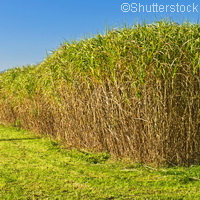Scientists map genetic energy crop
A British-American team of scientists and industry actors has developed the first high-resolution, comprehensive map of a promising energy crop called Miscanthus, what experts describe as a tall, cane-like grass that can be used as a feedstock for biofuels, bioproducts and biopower. Presented in the journal PLoS ONE, the study provides key insight into research efforts that seek to make bioenergy production a reality. Scientists from the Institute of Biological, Environmental and Rural Sciences (IBERS) at Aberystwyth University in Wales and staff from Ceres Inc., a United States-based energy crop group, cooperated on this project. The Welsh team created the collection of genetically related plants, while the American group sequenced and evaluated the deoxyribonucleic acid (DNA). The researchers said such genetic mapping shortened product development timelines of other crops. Overall, the 19 chromosomes of Miscanthus were mapped. The team produced and analysed over 400 million DNA sequences, and generated a blueprint of the plant's genetic alphabet. They identified 20 000 genetic differences, i.e. markers, which permit geneticists to distinguish single plants according to the tiny variations in their DNA. Using over 3 500 of these markers, they created the genetic map. According to the team, the markers are important and can be used to determine ways to improve crops. Past studies had only identified around 600 markers. They had also failed to characterise the structure of all the Miscanthus chromosomes. Characterising the structure was key to setting up a state-of-the-art plant breeding programme. 'By defining the genetic diversity in our germplasm collections with the new DNA markers,' said Dr Richard Flavell of Ceres, 'we can more rapidly introduce important crop traits into our new, seed-propagated Miscanthus products. The team expects less time, money and effort will be needed to breed the seeds in various environments. Growers will also benefit from their discovery. 'The joint Miscanthus development programme with Ceres has provided new insight into the evolution of the species as well as the similarities and differences in populations across different countries and environments,' IBERS' Dr Iain Donnison said. 'This rich library of information took decades to produce in other crops, but with modern biology and genomics technology, Ceres and IBERS have put together what I believe is one of the world's most comprehensive marker-based breeding programmes in Miscanthus.' The study was backed by the Biotechnology and Biological Sciences Research Council Sustainable Bioenergy Centre (BSBEC) in the United Kingdom. Commenting on the study, BSBEC's Professor Douglas Kell said: 'This partnership between academia and industry makes a significant contribution towards achieving sustainable feedstock for renewable energy and other bio derived products. A genetic map paves the way toward breeding improvements to increase the amount of sunlight captured, the amount of carbon that can be assimilated over a growing season and the partitioning of the carbon in harvested biomass. This research is an important step towards improving yields for bio feedstock without increasing inputs.'For more information, please visit: PLoS ONE:http://www.plosone.org/home.actionAberystwyth University:http://www.aber.ac.uk/en/
Countries
United Kingdom, United States



